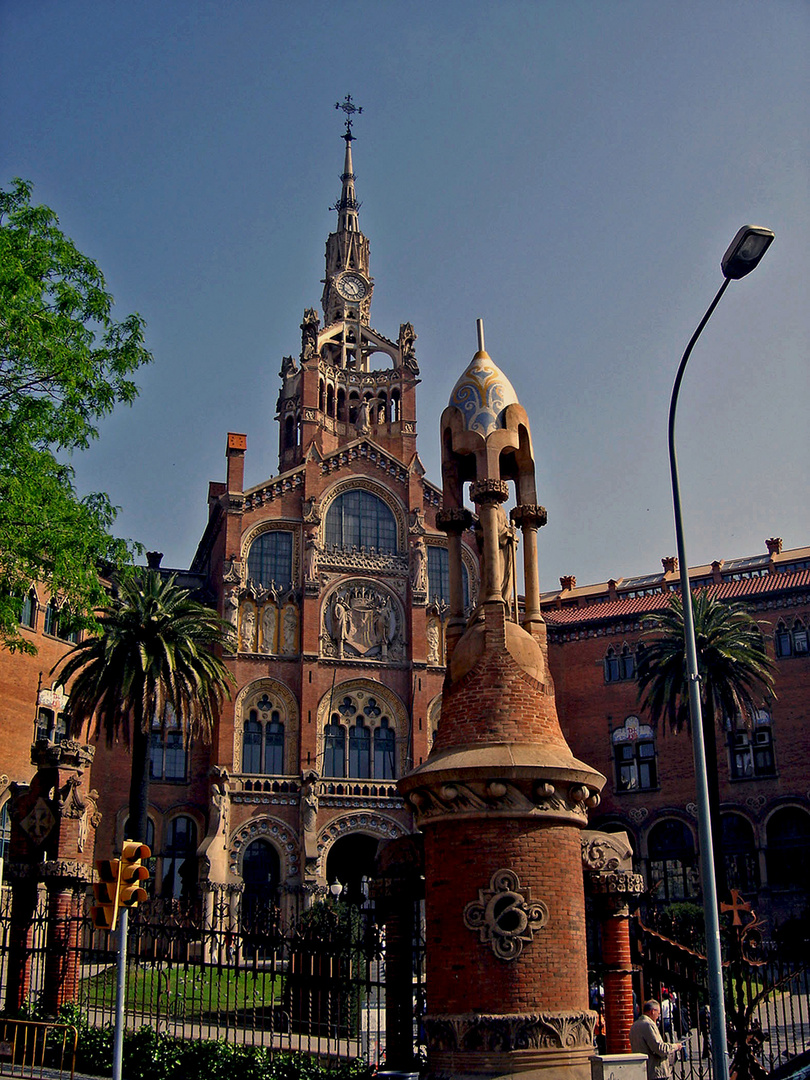Hospital de la Santa Creu i Sant Pau Façade, Barcelona
Hospital de la Santa Creu i Sant Pau
Hospital de la Santa Creu i Sant Pau, (English: Hospital of the Holy Cross and Saint Paul) in the neighborhood of El Guinardó, Barcelona, Catalonia, is a complex built between 1901 and 1930, designed by the Catalan modernist architect Lluís Domènech i Montaner. Together with Palau de la Música Catalana, it is a UNESCO World Heritage Site.
Although the hospital's current buildings date from the 20th century, the Hospital de Sant Pau was founded in 1401 when six small medieval hospitals merged. The hospital's former buildings near the center of Barcelona date from the 15th century, and now house an art school (Escola Massana) and Biblioteca de Catalunya (National Library of Catalonia).
http://www.santpau.cat/
http://en.wikipedia.org/wiki/Hospital_de_Sant_Pau
Antoni Gaudí
Antoni Gaudí i Cornet (25 June 1852 – 10 June 1926) is one of the outstanding figures of Catalan culture and international architecture. He was born in Baix Camp (Reus, Riudoms), but it was in Barcelona that he studied, worked and lived with his family. It is also in the city that we find most of his work. He was first and foremost an architect, but he also designed furniture and objects and worked in town planning and landscaping, amongst other disciplines. In all those fields he developed a highly expressive language of his own and created a body of work that speaks directly to the senses. Gaudí's works reflect his highly individual and distinctive style and are largely concentrated in the Catalan capital of Barcelona, notably his magnum opus, the Sagrada Família.
Much of Gaudí's work was marked by his big passions in life: architecture, nature, religion. Gaudí studied every detail of his creations, integrating into his architecture a series of crafts in which he was skilled: ceramics, stained glass, wrought ironwork forging and carpentry. He introduced new techniques in the treatment of materials, such as ‘trencadís’, made of waste ceramic pieces.
After a few years, under the influence of neo-Gothic art and Oriental techniques, Gaudí became part of the Modernista movement which was reaching its peak in the late 19th and early 20th centuries. His work transcended mainstream Modernism, culminating in an organic style inspired by nature. Gaudí rarely drew detailed plans of his works, instead preferring to create them as three-dimensional scale models and molding the details as he was conceiving them.
Gaudí spent most of his professional career building the Expiatory Church of La Sagrada Família, He received the commission in late 1883 and it occupied the his whole life. He did other work there, such as the Provisional Schools of La Sagrada Família (1909), and the construction of the workshop, where he worked with models and photographs, and where for his final years he went to live to follow the work from closer up. Walter Gropius came to the church in 1907, but did not manage to talk to Gaudí, "who was working busily".
In 1910 Güell promoted an exhibition of Gaudí's work at Le Grand Palais in Paris, It had a certain international echo, which reached as far as the United States and introduced him to the architect Sullivan (Chicago School). A few years later, in 1922, the Congress of Spanish Architects was held in Barcelona and supported his work. The same year he received a commission to do a project for a church for Our Lady of Rancagua, in Chile, for which he proposed to build the chapel of the Assumption in the apse. In 1923-1924 the architects Neufert and Linder, on the advice of Walter Gropius, visited Gaudí. They made friends with him and published an important article in the journal Deutsche Bauzeitung.
Gaudí's work enjoys widespread international appeal and many studies are devoted to understanding his architecture. Today, his work finds admirers among architects and the general public alike. His masterpiece, the still-uncompleted Sagrada Família, is one of the most visited monuments in Catalonia. Between 1984 and 2005, seven of his works were declared World Heritage Sites by UNESCO. Gaudí's Roman Catholic faith intensified during his life and religious images permeate his work. This earned him the nickname "God's Architect" and led to calls for his beatification.
On 7 June 1926, Gaudí was taking his daily walk to the Sant Felip Neri church for his habitual prayer and confession. While walking along the Gran Via de les Corts Catalanes between Girona and Bailén streets, he was struck by a passing tram and lost consciousness. Assumed to be a beggar because of his lack of identity documents and shabby clothing, the unconscious Gaudí did not receive immediate aid. Eventually a police officer transported him in a taxi to the Santa Creu Hospital, where he received rudimentary care. By the time that the chaplain of the Sagrada Família, Mosén Gil Parés, recognised him on the following day, Gaudí's condition had deteriorated too severely to benefit from additional treatment. Gaudí died on 10 June 1926 at the age of 73 and was buried two days later on 12 June in the Carmen chapel in the crypt of La Sagrada Família. His coffin, which was carried through a large part of the city, was followed by a crowd who wanted to say farewell to the man who was the city's most illustrious architect.
His gravestone bears this inscription:
Antonius Gaudí Cornet. Reusensis. Annos natus LXXIV, vitae exemplaris vir, eximiusque artifex, mirabilis operis hujus, templi auctor, pie obiit Barcinone die X Junii MCMXXVI, hinc cineres tanti hominis, resurrectionem mortuorum expectant. R.I.P.
http://en.wikipedia.org/wiki/Antoni_Gaud%C3%AD










Otto-Hans 07/12/2013 15:31
Thank you for the explanation. Best regards from Barcelona. Otto.Amit Banerjee 06/12/2013 19:50
Thank you. Please see legend "designed by the Catalan modernist architect Lluís Domènech i Montaner." This is the last picture of my 20 photo tribute to Antoni Gaudí; he died here on 10 June 1926, after an accident and for not receiving treatment after it as he was taken as a 'beggar'.Otto-Hans 06/12/2013 19:40
+++ You post su much about the architect Antoni Gaudí, but he was no the architect of this hospital +++